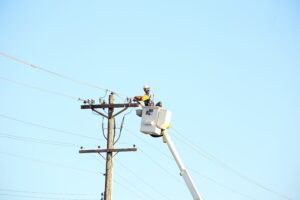Risk Management in Electrical Utilities: How to Boost Operational Resilience and Respond to Emergencies
By Roger Guerrero, Contributor

Electric utility companies face threats every day, whether natural disasters or emergencies caused by people. Photo courtesy of Juvare.
Electric utility companies face threats every day, whether natural disasters or emergencies caused by people. Historic cold streaks have battered power systems in the South and glitches have shut down three times more power than expected during rolling blackouts in Louisiana. Devastating wildfires have downed, and been caused by, electric utilities in the West. Whether preparing for a hurricane, life-threatening tornado, or a severe winter storm, utility companies must incorporate strong risk management to stand resilient in the face of adversity. Disruptions such as operational and system failures can bring long-lasting damage to both communities and electric utility providers, and leaders must make changes to increase operational resilience and situational awareness.
Electrical utilities can strengthen their organization’s operational resilience by focusing on clear communication between public and private sectors to make the right decisions. This starts by reviewing the latest state and federal standards on preparedness, helping utilities avoid costly fines and legal exposure due to a failure to act proactively or react to adverse conditions. A lack of regulatory compliance can also lead to reputational damage for your organization – a potential threat to business continuity. Incident management technology will empower electric utility organizations to adapt to regulatory changes, avoid litigation, and improve operational resilience.
Here are some ways that utility providers can improve risk management and boost operational resilience.
Assess Emergency Preparedness:
The first step in improving operational resilience is to assess the level of preparedness for emergencies and the range of capabilities accessible for a strong response. By routinely assessing emergency preparedness, the chances of property, facilities, and equipment suffering severe damage will decrease. Emergency preparedness also ensures that utility companies meet regulatory standards and avoid costly downtime. During this assessment, identify points of failure that require a shore up. The key to emergency preparedness is collaborating with stakeholders to share real-time data across existing networks and infrastructure.
Build a Communication Plan:
Utility providers must create executive communication plans that serve both their internal and external partners. To work together to achieve true operational resilience, efficient data exchanges across internal and external teams and processes through the use of technology is critical. Technologies that enable reliable communication between essential parties and support an active response and recovery lead to faster communications and better incident responses. They enhance utility providers’ situational awareness, a key component in the grand scheme of resilience. Automation, for example, makes incident management more effective and allows local and state agencies to stay connected during emergencies for optimal awareness and coordination of response and recovery. Proper communication also supports the social well-being of local communities.
Map Responses to Potential Threats:
Provide access to detailed maps to aid in both initial response efforts and later repair and restoration work. Detailed mapping is invaluable for first responders as they prepare for and respond to potential threats. They will need to remain aware of utilities’ infrastructure and activities in the field, a critical component for utility crews and first responders to remain aware of evacuation status and right to return orders. More detailed maps that show emergency locations, area conditions, and whether electricity is still active in certain areas will also ensure everybody is on the same page. In addition, mapping lets you track dispatched personnel and ensure they are connected to the resources they need to respond to the emergency. After the threat is mitigated, detailed maps can support a coordinated and efficient restoration effort by showing priority issues, tracking which areas have been brought back online, and enabling better communication between incident commanders and crews in the field.

Detailed mapping is invaluable for first responders as they prepare for and respond to potential threats. Photo courtesy of Juvare.
Participate in Regular Drills and Tabletop Exercises:
In 2022, utility crews maintain situational awareness during a natural and human-caused disaster by using software to maintain daily logs and share data with third-party response teams. Software tools keep utility providers ready through drills and tabletop exercises that prepare teams for all sorts of disasters. Keep emergency readiness apps accessible on digital devices and conduct routine trainings and drills to ensure everyone understands how to use the technology. Utility providers should deploy both surprise drills and scheduled drills that occur at least once every quarter.
Complete the Planning Loop:
The final step in building operational resilience for utility providers involves completing the loop and planning and practicing for a successful recovery. Following a disaster, you will return to operations through a process that requires planning and reviewing the recovery. Re-evaluate goals and learn from past mistakes to prepare for subsequent recoveries. Emergency management systems and processes, in combination with a work culture that always looks a few steps ahead, keeps emerging threats in view and helps ensure the response to future disasters will be even more successful.
Operational Resilience for the Future
Being prepared for emergencies through maintaining an effective risk management strategy comes down to maintaining reliable communication channels between all integral parties, including power plants, first responders, EMTs, and government officials ― a single source of truth for all stakeholders. Using helpful software tools with integrated emergency management can automate processes and maintain visibility across where your organization should manage risk and bolster defenses. Whether it is a wildfire out West or a hurricane in the East, the right level of operational resilience will keep utility providers prepared with a quick response plan for the next time disaster strikes. ESW
Roger Guerrero is Director of Business Development, Juvare (www.juvare.com).
Share on Socials!
Electrical Safety Statistics: Why Are Workers Still Dying on the Job
NFPA 70E® 2021 for Electrical Safety in the Workplace®
How to Prevent and Respond to Arc Flash Injuries
Leaders in Electrical Safety
• Aramark
• Bowtie Engineering
• Enespro
• Ericson
• I-Gard Corporation
• IRISS
• KERMEL, INC.
• Lakeland Industries
• MELTRIC Corporation
• National Safety Apparel
• National Technology Transfer
• Oberon
• Saf-T-Gard
• SEAM Group
Subscribe!
Sign up to receive our industry publications for FREE!







